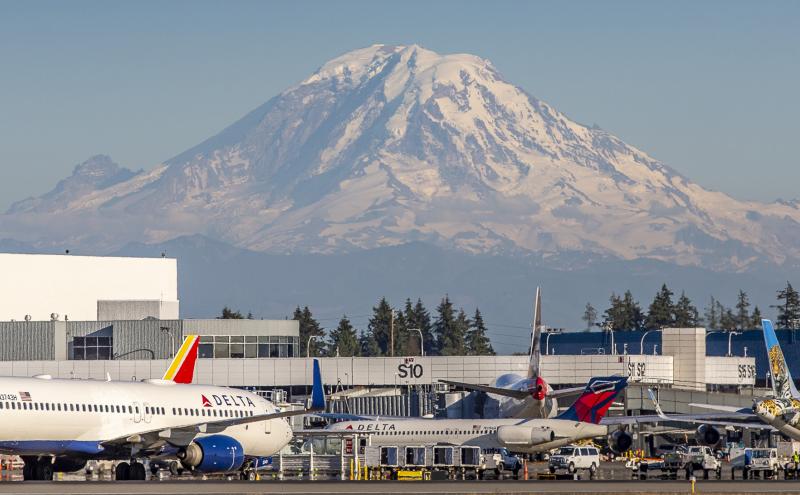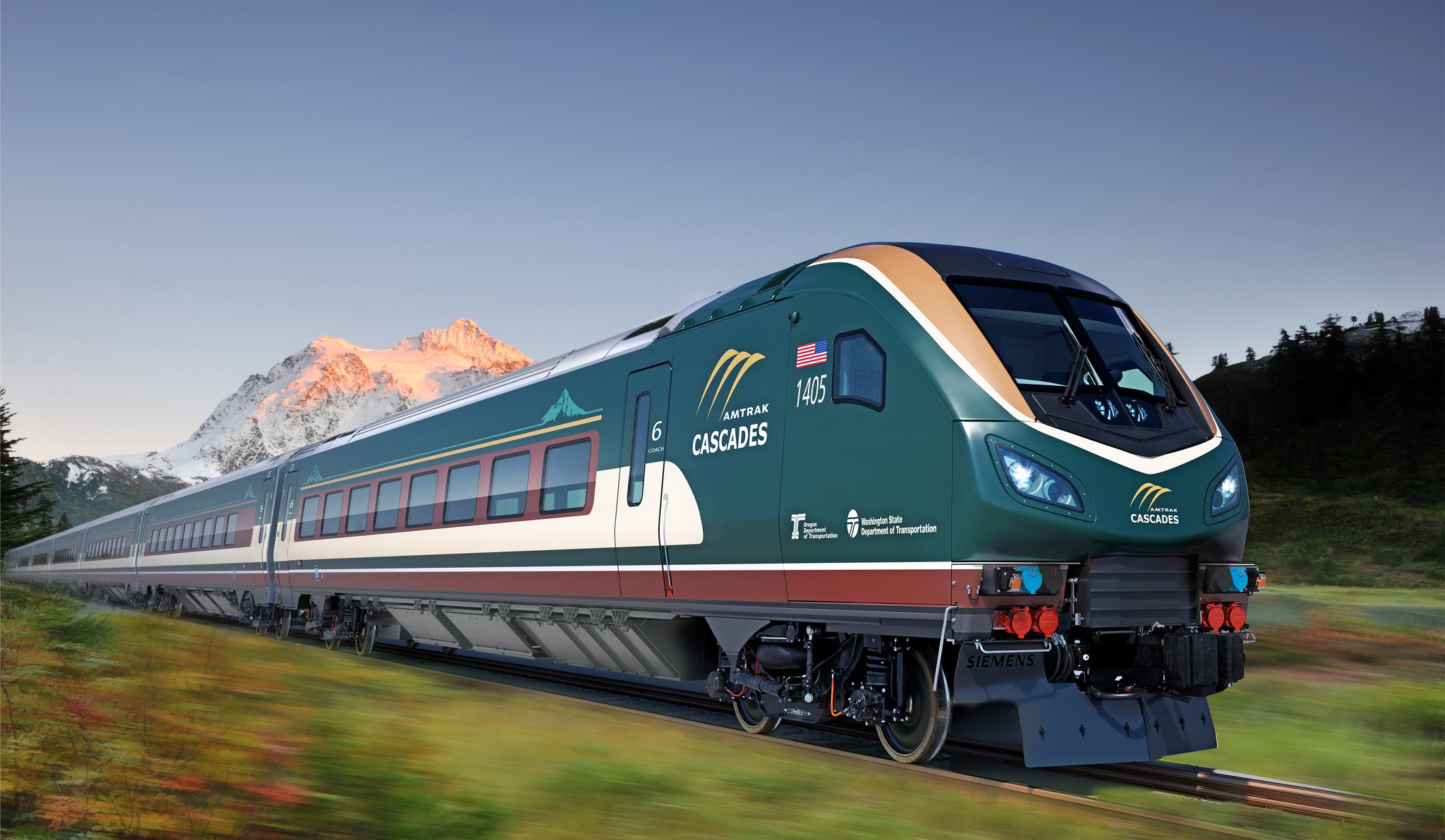04/12/2023 – By Frédéric de Kemmeter – Railway signalling and freelance copywriter – Suscribe my blog
🟧 Back to homepage 🟧 See our brief news 🟧 UK 🟧 China 🟧 Japan 🟧 USA 🟧 the rest of the world
Austria – Baltic States – Czech Republic – Finland – France – Germany – Italy – Netherlands – Norway – Poland – Portugal – Republic of Ireland
– Slovakia – Spain – Sweden – Switzerland – Ukraine
Cascadia Rail is a project which support to connect Portland, Seattle and Vancouver and avoid shuttles by plane between these cities. The target is to create station locations in downtowns, airports, and employment centers, where the most people will use them. These station locations would be connected with existing bus/rail networks and ticket prices would be affordable for the most people The project will be build to meet our climate goals of 2030.
It’s always interesting to keep an eye on high-speed rail projects in the USA, a very modern country that has nevertheless turned its back on passenger rail, preferring fossil-fuelled modes of transport.
The only railway’s project actually under construction is the California High-Speed Rail, only part of which is under construction near San Fransisco. Another project is the Texas Central line linking Dallas and Houston. More recently, comes the Brightline’s Las Vegas to Los Angeles line idea that has set an aggressive timeline to operate by 2028. As is always the case in the USA, these projects can only come to fruition with a good deal of private funding. The United States does not have the culture of large-scale state projects as we know them in Europe or Asia.
Cascadia Rail, an organization founded in 2018, started the advocacy and early ideation work of HSR traversing through the Cascadia region. What sets Cascadia High Speed Rail project apart from the other two projects mentioned above is its international component. It will link Portland and Seattle, USA, with Vancouver, Canada. The aim of the project is to provide a new highly attractive intercity and commuter travel mode for the Pacific Northwest, a region said to be growing fast.

In 2016, Governor Jay Inslee reportedly asked WSDOT, the Washington State Department of Transportation, for a study for rapid transit in the state as well as linked with its neighbors, Oregon and British Columbia in Canada. In his part, in June 2023, the University of Washington (UW) by his Mobility Innovation Center & Urban Infrastructure Lab, submitted its report — Keeping it on the Tracks. Led by faculty Dr. Jan Whittington & Dr. Qing Shen, the purpose of the study is to inform the nascent consideration of high-speed rail in Cascadia with key facts and the opinions of experts distilled from other active and successful projects. The focus is to identify topics that, if taken up today, hold the promise of improving the prospects of project success. The study is meant to help ask and integrate the appropriate ways of thinking in order to plan and successfully build HSR in a reasonable time frame and at a reasonable cost. WSDOT released its HSR update report in June as well. The results showed the feasibility of a high-speed line capable of 350km/h along Interstate no. 5, with a transport capacity of 32,000 passengers per hour.

One of the reasons for this railway project is the planned saturation of Seattle-Tacoma International Airport (SEA), the 11th largest in the United States with over 22 million passengers. The Puget Sound Regional Council predicts that passenger numbers will double by 2050. The desired extensions to this airport would quickly reach their limits and the people living nearby obviously don’t support these extensions and the nuisances that go with them.
The main idea for Seattle would be to shift many, if not all, short-haul flights between the 3 cities to rail rather than air. The slots gained would be allocated to long-haul flights, particularly to and from Asia, to which Seattle and Vancouver have become gateways over the years. According to some experts, the airlines are not opposed to this transfer, since short-haul flights don’t generate much revenue, and sometimes even losses. Long-haul flights, on the other hand, are much more profitable, and are preferred by the pilot profession.
Transferring the 30 flights a day between Seattle and Portland and the 30 flights to Vancouver requires a completely different approach to what is available today. Clearly, the current rail service has no chance of being competitive. Yesterday’s was no different. In the years 1950 , the International route Seattle-Vancouver offered three daily services both northbound and southbound, with additional stops in Everett, Mount Vernon, Bellingham, Blaine, White Rock, and New Westminster, the latter three of which are no longer accessible by rail. Today, the departure of lone Cascades train from Vancouver is at 5:45pm arrives in Seattle at 10:10pm, meaning travelers wishing to move to further destinations must find a room to stay overnight in Seattle, explains The Urbanist. Though, Amtrak, whose services have not really changed or improved much in the last twenty years, saw its market (riders) increase by 50 percent for their system and its intercity corridors typically increased by over 100 to 200 percent.
It was also important to compare the costs of a new rail line and airport extensions. In the case of Seattle, the construction of a new airport was weighed in the balance, as the expansion possibilities at the current airport alone could only absorb growth until around 2030, and no longer. However, the cost of a rail line linking three cities can not be compared with the extensions to a single airport, but with the 4 airports that the Cascadia project intends to link (including Everett, north of Seattle). The whole rail line would cost up to $42 billion, figures that we know can sometimes climb higher, as we saw with HS2 in Great Britain. However, this line would also incorporate more local services designed to better connect the airports with their direct hinterland, something that current services in Portland, Seattle and Vancouver do absolutely nothing to achieve. As shows the map, the line continues for example to Eugene, a city in the south of Portland.
In addition, the line plans to build stations in a dozen intermediate towns where customers on long-haul flights live, as well as for people working towards the three major Pacific cities. This aspect is just as important as the high speed itself, in an America where people are not used to going to work or to town by train. The Cascadia project hopes to create a significant property development program at stations along the corridor, to revitalize and produce significant economic growth surrounding each station stop that can help reduce urban sprawl. These developments in the large cities may well encompass 40-60 blocks near the stations and produce billions of dollars of development such as those already developed in Europe and Asia.
The Cascadia project also highlights the carbon-free nature of trains, which are powered 100% by electricity, unlike cars or planes. A low-carbon rail project is one of the solutions for a more sustainable future for this growing region. We’ll have to wait and see how things develop… 🟧

Interesting to read:
- 2020 – The Urbanist – Washington’s Draft State Rail Plan Presents Foggy But Modest Future
- 2023 – Markus Johnson – Reflections: How to Plan for Cascadia’s High Speed Rail
Similar articles:
 How Asia became the first high-speed rail continent
How Asia became the first high-speed rail continent
07/11/2023 – Asia, initially led by Japan and now by China, is dominating the high-speed rail sector, outpacing Europe and leaving North America behind. High-speed rail began in Japan in the 1960s, with top speeds rising over decades from 210km/h to a typical 350km/h…
 Asia takes leadership of trains at 600km / h, and itsn’t good news for Europe and America– 30/05/2019 – The Chinese manufacturer CRRC, which is so scary to European manufacturers, unveils a magnetic levitation train project that could circulate at 600km/h. The magnetic levitation train can be defined as a high-speed train, but not only. In 1984, in Birmingham, a train operated on an elevated 600m…
Asia takes leadership of trains at 600km / h, and itsn’t good news for Europe and America– 30/05/2019 – The Chinese manufacturer CRRC, which is so scary to European manufacturers, unveils a magnetic levitation train project that could circulate at 600km/h. The magnetic levitation train can be defined as a high-speed train, but not only. In 1984, in Birmingham, a train operated on an elevated 600m…
 HS2 at a minimum: what this tells us about Great Britain
HS2 at a minimum: what this tells us about Great Britain
03/11/2023 – The government officially scrapped the northern section of the HS2 high-speed rail network at the beginning of October, during a speech in Manchester. The HS2 project will be limited to Birmingham, in the West Midlands, and will go no further. This sheds a harsh light on Britain and the way it handles major…
04/12/2023 – By Frédéric de Kemmeter – Railway signalling and freelance copywriter – Suscribe my blog
🟧 Back to homepage 🟧 See our brief news 🟧 UK 🟧 China 🟧 Japan 🟧 USA 🟧 the rest of the world
Austria – Baltic States – Czech Republic – Finland – France – Germany – Italy – Netherlands – Norway – Poland – Portugal – Republic of Ireland
– Slovakia – Spain – Sweden – Switzerland – Ukraine

